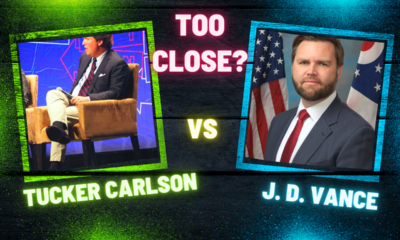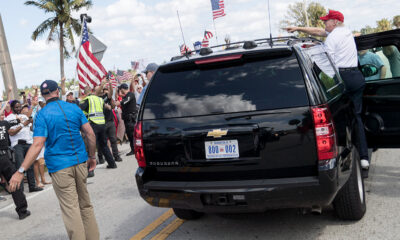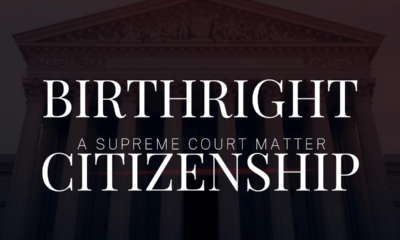Constitution
Executive powers and their limits
Do executive powers have any Constitutional limits? The Supreme Court has two cases left on its docket to decide precisely that.
Today the Supreme Court punted, for one more day, on two major cases concerning executive powers. One case involves an Executive Order, and the other an executive agency. The Court, if it applies the Constitution as it has in recent cases, should decide these two remaining cases against the federal government.
Supreme Court update
Today the Court released two of the four opinions left on its docket. One case concerned the mess resulting from the failure to disestablish properly the Creek Nation reservation. (McGirt v. Oklahoma.) Technically that reservation still exists – and covers most of eastern Oklahoma, including Tulsa. In 2015, a negligent father stood trial for child neglect in the case of his daughter – a Cherokee. In light of the McGirt case, this man argued that only the federal government had authority to prosecute him. The Supreme Court held that in fact the federal government shares jurisdiction with State governments over crimes in which one party is a Native American and the other is not. (Oklahoma v. Castro-Huerta, 21-429.)
Swing votes
The other case involved a U.S. Army Reserve veteran, a state trooper who went to Iraq when the Army deployed him there. While in Iraq he was exposed to the fumes from “toxic burn pits,” that incinerate all manner of trash in one pile. He returned home with constrictive lung disease and asked the Texas Department of Public Safety to give him a desk job. They refused, and he lost his job. That’s not supposed to happen, under the Uniformed Services Employment and Reemployment Rights Act of 1994 (USERRA). The trooper sued in the Texas courts. The trial court refused the State’s motion to dismiss, but a Texas appeals court reversed that and dismissed the complaint. They cited the “sovereign immunity” of Texas from lawsuits under USERRA or any other such mandate.
Today the Supreme Court said Texas surrendered sovereign immunity in any exercise of Congress’ power “to raise and support armies.” Kavanaugh and Roberts both “swung” with the liberals to find for the trooper. Justice Thomas, in his dissent, questioned whether unfunded mandates and standing for private employment suits are valid exercises of the war-making powers. (Torres v. Texas Department of Public Safety, 20-603.)
The Supreme Court, at about 10:30 a.m. EDT, designated Thursday, June 30, as another Opinion Issuance Day. The two executive powers cases at issue, are the only two cases left for the Court to decide this Term.
Executive powers from the Constitution
The Constitution defines the powers and duties of the President. These come from Articles I and II. His chief Article I power is the veto, which Congress may override. Beyond that he has the treaty-making power, subject to two-thirds Senate ratification. The President also has the appointment power, subject to Senate confirmation – except that he can appoint people temporarily when Congress is in recess. He also has the reprieve and pardon power, and in this he defers to no one.
But he does not have the power to make law. And while he may grant reprieves and pardons, he may not try or convict someone. These limits should apply to every agency of the government under the President. Traditionally, they have, except for the unique power of the military to try and convict its own by court-martial.
But successive Presidents have abused the executive powers, and assumed the authority both to make law and to convict people.
Abuse of executive powers
A President has two methods for this abuse and excession of executive powers. First is the Executive Order. By tradition, an Executive Order should set policy within the executive branch – meaning for executive departments and agencies. But we have lately seen Executive Orders that clearly encroach upon the powers of Congress.
The case of Biden v. Texas (21-954) raises this very issue. President Trump declared that those applying for entry visas from Mexico should remain in Mexico while the authorities are processing their applications. A particular federal law (8 USC § 1225) governs the handling of such cases. President Biden, through the Secretary of Homeland Security, canceled that requirement.
The State of Texas sued the federal government over this. In the latest action, the Court of Appeals for the Fifth Circuit held the Secretary of Homeland Security had no proper authority to end the Remain in Mexico policy. In December of 2021, the President took it to the Supreme Court, which granted certiorari.
The case has seen a dizzying number of friend-of-the-court briefs in addition to the petitioner’s and respondents’ brief. Even after oral argument, the Court asked for more briefs. Interestingly, they asked for these “supplemental briefs” on the very day of the Great Leak in the Dobbs case. The latest action came on June 6, in the form of “statistical corrections” to some of the government’s supporting reports.
Executive powers method two: executive agencies
The other executive powers case has received far more attention: West Virginia v. Environmental Protection Agency (20-1530). At issue here is a supplement to the Clean Air Act (42 USC § 7411(d)). This law sets forth some of the powers and duties of the Environmental Protection Agency (EPA). As such it represents a delegation of legislative authority to the EPA. The real issue before the Court is whether the EPA exceeded its authority.
Here is the relevant text:
- The Administrator shall prescribe regulations which shall establish a procedure similar to that provided by section 7410 of this title under which each State shall submit to the Administrator a plan which
- establishes standards of performance for any existing source for any air pollutant
- for which air quality criteria have not been issued or which is not included on a list published under section 7408(a) of this title or emitted from a source category which is regulated under section 7412 of this title but
- to which a standard of performance under this section would apply if such existing source were a new source, and
- provides for the implementation and enforcement of such standards of performance. Regulations of the Administrator under this paragraph shall permit the State in applying a standard of performance to any particular source under a plan submitted under this paragraph to take into consideration, among other factors, the remaining useful life of the existing source to which such standard applies.
- establishes standards of performance for any existing source for any air pollutant
Superseding the States
The text of Section 7411(d) goes further. If a State refuses to submit such a “standard of performance” plan, the EPA may do it for them. This also applies if the EPA Administrator deems a State’s plan unsatisfactory. Which is another problem: only the Administrator decides satisfaction of a State’s anti-pollution plan.
This case consolidates three other cases, and its argument has spanned two terms. The Supreme Court must decide whether or not the Congress:
- Meant to authorize the EPA to declare something a pollutant and make rules with no limits other than cost considerations, and
- Had the authority under the Constitution so to act.
Carbon dioxide as a pollutant?
The particular “air pollutant” at issue makes the issue an order of magnitude worse. It is carbon dioxide, the same gas plants breathe in to make sugar, starch or cellulose. Carbon dioxide, say some, is a “greenhouse gas” present in dangerously excessive amounts in our atmosphere. If we don’t take carbon dioxide out of the atmosphere, they say, Earth’s weather will grow fatally stuffy.
On that ground, President Barack H. Obama declared carbon dioxide a pollutant. In 2009, he submitted to Congress a “cap and trade” law for consideration. Then-Representatives Henry Waxman (D-Calif.) and Edward Markey (D-Mass.) agreed to shepherd this through the House of Representatives. Then-Senators John Kerry (D-Mass.) and Barbara Boxer (D-Calif.) did the honors in the Senate.
In the middle of these deliberations, the Climategate story broke. Breaking as it did shortly before the Fifteenth Conference of Parties to the United Nations Framework Convention on Climate Change, this story effectively prevented the Parties from coming to an agreement. (Which is why the Big International Agreement is the Paris Agreement, not the Copenhagen Agreement.) It also dampened the enthusiasm for the Waxman/Markey and Kerry/Boxer cap-and-trade scheme in Congress. Though Democrats controlled both Houses, too many Democrats quailed in the face of angry constituent telephone calls telling them NO. (Which means calling your Senator or Representative is always worth doing, just to get yourself on record.)
Obama’s order: do it anyway!
Facing this loss, Obama told his EPA Administrator to find, unilaterally, that carbon dioxide is a pollutant and act accordingly. Which the EPA did, per 42 USC § 7411(d). (And also as per Massachusetts v. EPA, 2007.)
This issue would probably have enabled any Republican except their nominee, Mitt Romney, to defeat Obama for re-election. (Romney ran his campaign to lose.) It certainly enabled Donald Trump to win election against Hillary Clinton, whom Obama picked by hand to succeed him. As we know, Trump not only withdrew America from the Paris Agreement, but he also curtailed the EPA’s actions. He ordered this in 2019, according to the Federal Respondents’ brief.
As we also know, the Electoral College elected Joe Biden to begin serving as President on January 20, 2021. On the day before the Inauguration, the Court of Appeals for the District of Columbia vacated the the EPA curtailment. But it stayed its vacating of the rule, apparently because the carbon emissions at issue were already within limits. Yet the Federal Respondents have not mentioned the reason for the fall in emissions. That reason is the overall curtailment of economic activity due entirely to stay-at-home and other orders relating to coronavirus. One can understand that the petitioners do not want the EPA to stop any hope of economic recovery as the country recognizes that coronavirus is not the Black Plague.
This is about executive powers
The basic principle before the Court is not whether carbon dioxide really is a pollutant. (Indeed the Court has never appointed any Special Masters to look into that issue.) Nor is it whether letting aliens apply for immigration visas while in the United States is wise, or foolish. Those considerations are incidental. The point concerns the full extent of executive powers, whether under the Constitution or “inherent.”
Any government at any level, and any branch of such a government, has three kinds of powers. Constitutions, and laws of government of higher authority, confer expressed powers. A government may infer implied powers from text that doesn’t exactly expressly grant a power, but grants powers in related areas. Finally, any government claims inherent powers without which they simply aren’t governments. Eminent domain, for example, is an inherent power. The Constitution does not forbid that, but sets a limit on it. Raising and supporting armies is an expressed power – but raising and supporting air and space forces is an implied power.
In this case, the federal government seems to claim an inherent power, not only to regulate pollution but to decide what is, and what is not, a pollutant. And they propose to do so apart from any reasonably legislative process. Commentary periods for rulemaking are not the same as legislative debate. Nor do the people elect anyone at the EPA who makes such rules.
These powers are too great
All of which to say that Presidents, going clear back to Nixon and arguably Franklin Roosevelt, have too much power. Executive Orders can cut two ways. A President, by Executive Order, can unilaterally ignore his duty to “take care that the laws be faithfully executed.” Or he can make a new law and expect everyone to obey it as if Congress had passed it. A failure of faithful execution of law is at issue in Biden v. Texas.
The consolidated EPA case is worse. CNAV has before decried quasi-legislative and quasi-judicial executive agencies. Quasi- means partial – so quasi-legislative means having some of the powers of a legislature but none of its limits. Likewise quasi-judicial means having the order powers of a court but not subject to the checks and balances that apply to the courts.
This applies not only to the EPA but also to any other regulatory agency. Can Congress really delegate, to the President or an agency under him, the power to make law? You can call your Senator or Representative – but calling the EPA Administrator is a waste of time. Bureaucrats don’t take telephone calls from those their rules affect. (Or they’re not supposed to.)
Such an agency also has “administrative law judges” that judge whether you have broken the agency’s rules. Such judges need observe no rules of evidence, and are inherently partial to the agency’s stated goal. So no hearing or trial before one can ever be fair.
Asking the Court to curtail executive powers
Two other columnists now hope the Court will find against the government, specifically in the EPA case. Liz Peek wants to reserve to Congress the authority to decide what is and what isn’t a pollutant. Not only that, but she would like to see the debate on any kind of “regulation” back in the hands of Congress. Then all such rule-making would take place in committee – with witnesses and the public permitted to attend. “Public comment periods” do not substitute for such open debate.
We expect Congress to speak clearly if it wishes to assign to an agency decisions of vast economic and political significance.Justice Antonin Scalia
Robert Romano, writing at Self Reliance Central, sees a worse problem. In his analysis, the Court has sometimes established reliance interests on rulemaking. The case he cites involved motor-vehicle regulations, not environmental ones. But the principle remains the same. So the Court needs to clarify the ambiguous state of executive powers. The country must know how far such powers go.
The Court’s jurisprudence on executive powers has been all over the map. But today’s Supreme Court has not been shy about revoking certain exercises of executive powers as invalid. We saw that in the New York Gun Case. Perhaps we’ll see it again. If so, then the next time someone wants to denounce something as a pollutant, he’ll have to come to Congress. That will mean testifying and offering hard evidence, for everyone to see.
Terry A. Hurlbut has been a student of politics, philosophy, and science for more than 35 years. He is a graduate of Yale College and has served as a physician-level laboratory administrator in a 250-bed community hospital. He also is a serious student of the Bible, is conversant in its two primary original languages, and has followed the creation-science movement closely since 1993.
-

 Civilization23 hours ago
Civilization23 hours agoDC Pipe Bomb Arrest Raises Questions About Christopher’s Wray’s FBI
-

 Executive4 days ago
Executive4 days agoThe Last Supper: New York’s Socialist Feast
-

 Civilization4 days ago
Civilization4 days agoYoo Hoo, VP Vance—Your Character is Showing!
-

 Civilization5 days ago
Civilization5 days agoIvory Tower Thinking and Narcotics Boats
-

 Guest Columns3 days ago
Guest Columns3 days agoCongressional Leaders See Far Higher Stock Returns Than Peers
-

 Civilization2 days ago
Civilization2 days agoThe Legal Logic Behind U.S. Operations Against Narco-Terrorist Networks
-

 Civilization4 days ago
Civilization4 days agoFacing Facts & Rolling Back Mythologies: The New National Security Strategy
-

 Civilization3 days ago
Civilization3 days agoHow Trump Changed America















[…] set forth a background on these two cases yesterday, after the Court deferred until today their issuance of opinions. […]
[…] money-coining power – and the Necessary and Proper Clause (Article I, Section 8, Clause 18). (See here for our discussion of expressed, implied, and inherent powers of government.) By no accident, many […]
[…] to destroy the coal industry especially effecting the economy of the entire state of West Virginia. The EPA formulated regulations that required energy producers to transition coal-fired power plants to natural gas. The state […]